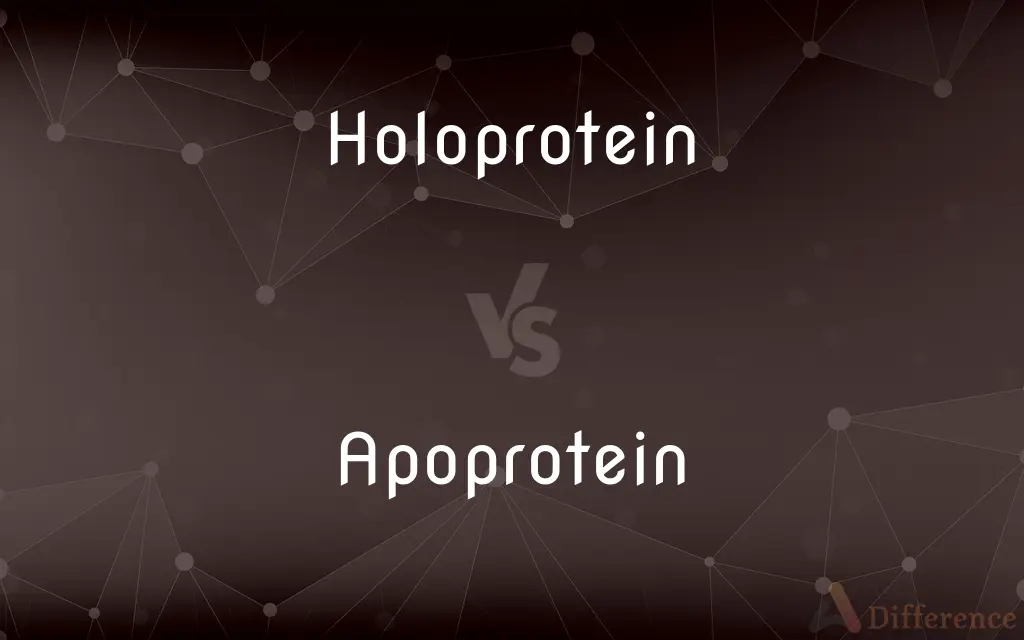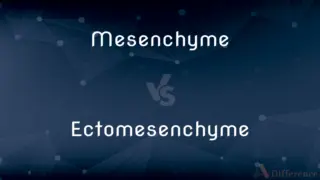Holoprotein vs. Apoprotein — What's the Difference?
By Tayyaba Rehman & Fiza Rafique — Updated on April 30, 2024
Holoproteins are complete proteins with their prosthetic groups, necessary for function, while apoproteins lack these groups, rendering them inactive.

Difference Between Holoprotein and Apoprotein
Table of Contents
ADVERTISEMENT
Key Differences
Holoproteins, also known as conjugated proteins, are fully functional proteins that include non-protein components called prosthetic groups. These groups are essential for the protein's biological activity and can include metal ions, vitamins, or other organic compounds. In contrast, apoproteins are the protein components alone, without their prosthetic groups, and are generally inactive until they are combined with the necessary non-protein elements.
The role of holoproteins in biological systems is diverse, as these proteins can function as enzymes, transporters, or structural components, depending on their prosthetic group. For example, hemoglobin is a holoprotein that requires iron-containing heme groups to bind and transport oxygen. On the other hand, without the heme, the apoprotein form of hemoglobin cannot function in oxygen transport.
Prosthetic groups are often critical for the structural integrity of holoproteins, influencing their three-dimensional shape and stability. The absence of these groups in apoproteins can lead to incorrect folding or instability, which underscores the essential nature of these conjugates for proper protein function. Conversely, apoproteins may sometimes function in cellular processes as transporters for their prosthetic groups, ensuring these vital components reach the right part of a cell or tissue.
The study of the interaction between apoproteins and their prosthetic groups is crucial in understanding diseases where these interactions are disrupted. For instance, in certain metabolic disorders, the failure of apoproteins to properly bind their prosthetic groups can lead to ineffective enzymes or transporters. Whereas, the proper study and manipulation of holoproteins can lead to therapeutic advancements in such conditions.
In research and biotechnology, apoproteins can be used to study how proteins interact with various molecules, as they provide a system where the effect of adding or removing a prosthetic group can be observed directly. Conversely, holoproteins are often used in their complete forms to understand the full range of protein functions in more physiological conditions.
ADVERTISEMENT
Comparison Chart
Definition
Complete, functional protein with prosthetic group.
Protein alone, without prosthetic group, usually inactive.
Function
Active in biological processes.
Inactive until combined with prosthetic group.
Example
Hemoglobin with heme.
Hemoglobin without heme.
Role in Disease
Functional disturbances relate to defective prosthetic groups.
Often involved in transport or storage of prosthetic groups.
Research Use
Studied for full biological activity.
Used to understand protein-prosthetic group interactions.
Compare with Definitions
Holoprotein
A conjugated protein integral to various biological functions.
Enzymes that catalyze essential reactions are often holoproteins.
Apoprotein
Lacks non-protein elements necessary for activity.
Apocytochrome c cannot transfer electrons without its heme group.
Holoprotein
A protein combined with a non-protein component essential for its function.
The holoprotein hemoglobin requires heme to transport oxygen in the blood.
Apoprotein
Useful in studies of protein folding and stability.
Studying apoproteins helps researchers understand how proteins misfold in diseases.
Holoprotein
Contains components crucial for structural stability and function.
Many holoproteins have metal ions as part of their structure.
Apoprotein
Protein component of a holoprotein, inactive without its prosthetic group.
The apoprotein form of lipoprotein carries lipids in the blood but requires specific lipids to function.
Holoprotein
Used in physiological studies to understand normal protein function.
Researchers study holoproteins to investigate how mutations affect function.
Apoprotein
Acts as a transporter for prosthetic groups within cells.
Apoproteins transport necessary cofactors to enzymatic sites.
Holoprotein
Fully active form of a protein with its prosthetic group.
Myoglobin is a holoprotein that binds oxygen in muscle cells.
Apoprotein
A target for research into protein-prosthetic group binding.
Biotechnologists manipulate apoproteins to enhance prosthetic group binding.
Holoprotein
A Holoprotein or conjugated protein is an apoprotein combined with its prosthetic group.Some enzymes do not need additional components to show full activity. Others require non-protein molecules called cofactors to be bound for activity.
Apoprotein
A protein which together with a prosthetic group forms a particular biochemical molecule such as a hormone or enzyme.
Holoprotein
(biochemistry) A conjugated protein; an apoprotein combined with its prosthetic group.
Apoprotein
(protein) The polypeptide part of a conjugated protein; for example, an apolipoprotein plus a lipid particle yields a lipoprotein.
Common Curiosities
What is an apoprotein?
An apoprotein is the protein component of a holoprotein, lacking its prosthetic group and typically inactive until the group is acquired.
Why are prosthetic groups important for proteins?
Prosthetic groups are crucial as they often enable the protein’s biological activity, affect its stability, and determine its three-dimensional structure.
What is a holoprotein?
A holoprotein is a complete, functional protein that includes both the protein itself and its necessary non-protein components, called prosthetic groups.
How do holoproteins differ from apoproteins?
Holoproteins are active and functional due to the presence of essential prosthetic groups, whereas apoproteins are inactive without these groups.
Are holoproteins more important than apoproteins?
Both are important for different scientific purposes: holoproteins for understanding full biological function and apoproteins for studying protein interactions and folding.
Can apoproteins function without their prosthetic groups?
Generally, no; apoproteins require their specific prosthetic groups to become active and perform their biological functions.
How are apoproteins used in medical research?
Apoproteins are studied to understand diseases caused by the improper assembly of proteins and their associated groups.
How do prosthetic groups affect the function of holoproteins?
Prosthetic groups can enable enzymatic activity, enhance structural stability, or allow for the binding and transport of other molecules.
Is there a way to convert an apoprotein into a holoprotein?
Yes, by adding the necessary prosthetic group under the right biochemical conditions, an apoprotein can become a functional holoprotein.
What are some common diseases associated with defects in holoproteins?
Diseases such as anemia (related to defects in hemoglobin) or various enzyme deficiencies can arise from issues with holoproteins.
What happens when a prosthetic group is missing from a protein?
The absence of a prosthetic group usually results in a non-functional protein, potentially leading to disease or dysfunction.
What role do holoproteins play in metabolism?
Holoproteins serve as enzymes that catalyze essential metabolic reactions, transporters that move molecules across membranes, and structural components in cells.
Can apoproteins become toxic if not properly bound to their prosthetic groups?
While not typically toxic, improperly formed apoproteins can lead to cellular dysfunction or disease due to their inactivity or instability.
What is the significance of studying both holoproteins and apoproteins?
Understanding both helps clarify how proteins work in healthy systems and what goes wrong in diseases, paving the way for targeted therapies and diagnostics.
Why might a researcher choose to study an apoprotein?
Studying apoproteins allows researchers to investigate how prosthetic groups influence protein function and how proteins fold or misfold.
Share Your Discovery

Previous Comparison
Mesenchyme vs. Ectomesenchyme
Next Comparison
Wyrm vs. WyvernAuthor Spotlight
Written by
Tayyaba RehmanTayyaba Rehman is a distinguished writer, currently serving as a primary contributor to askdifference.com. As a researcher in semantics and etymology, Tayyaba's passion for the complexity of languages and their distinctions has found a perfect home on the platform. Tayyaba delves into the intricacies of language, distinguishing between commonly confused words and phrases, thereby providing clarity for readers worldwide.
Co-written by
Fiza RafiqueFiza Rafique is a skilled content writer at AskDifference.com, where she meticulously refines and enhances written pieces. Drawing from her vast editorial expertise, Fiza ensures clarity, accuracy, and precision in every article. Passionate about language, she continually seeks to elevate the quality of content for readers worldwide.













































